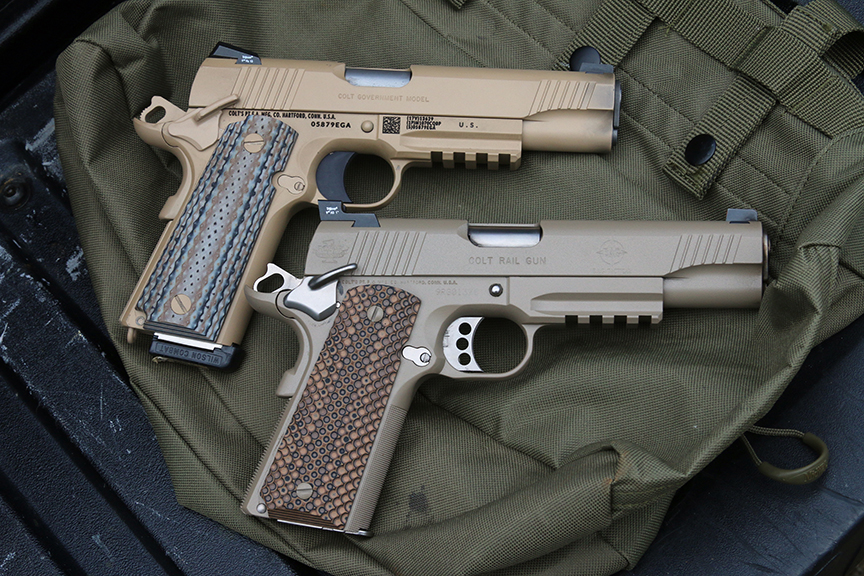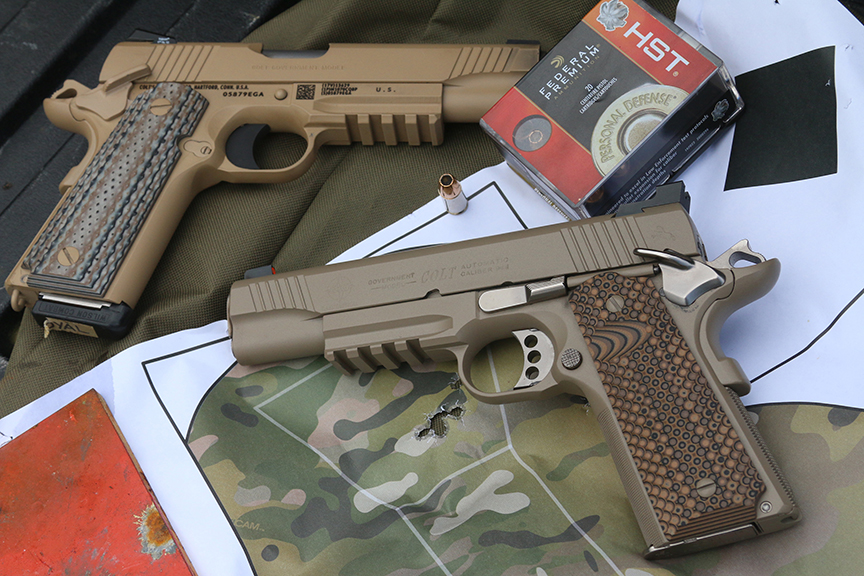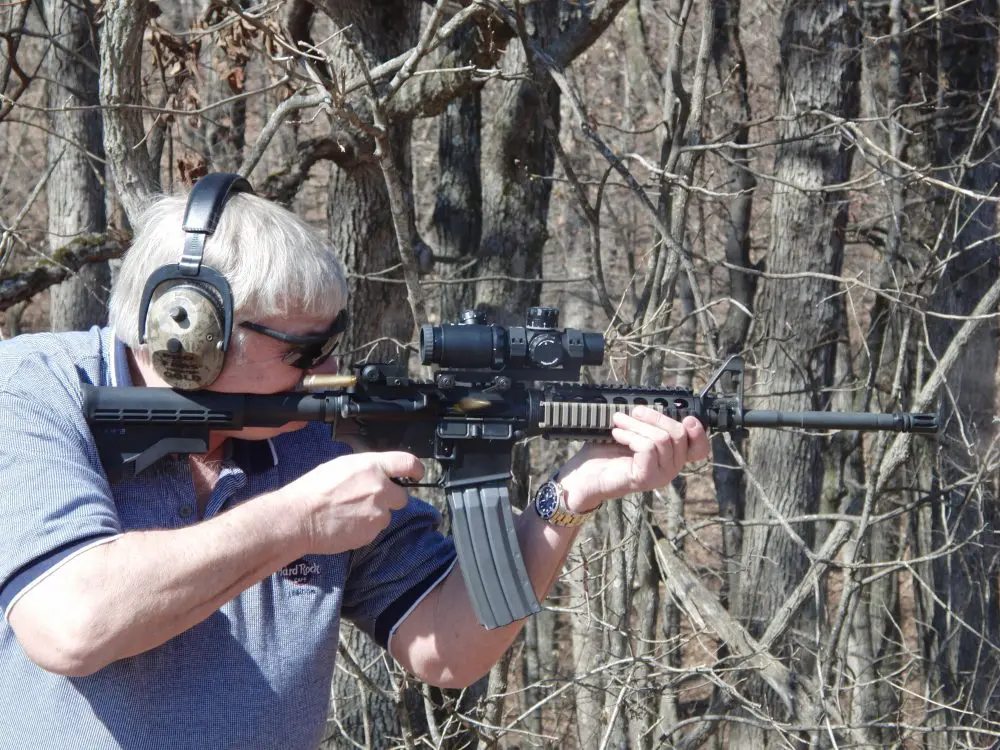
As S.W.A.T. readers know, Pat Rogers’ passing in 2016 left a gaping hole in the industry, the training community, and among countless “good guys” who considered him a friend, mentor, and role model.There have been many small efforts to memorialize Pat in a more lasting way than the frequent unprompted memories that many of us have. These include an excellent annual training event and fundraiser for his beloved National Museum of the Marine Corps held at his frequent training ground in the Alliance, Ohio Police training facility; a classroom there dedicated to Pat; some artwork of Filthy 14 (FILTHY 14: Bravo Company Carbine Goes 31,165 Rounds, October 2010 S.W.A.T.); and a small batch of special memorial rifles that weren’t offered to the public.
Lt. Colonel Freddie Blish, USMC (Ret.) of ROBAR has added a worthy tribute to that list: a memorial custom 1911 built and finished by his custom shop.
Pat Rogers lived an incredibly full life and was associated with many different things. Those who followed his writings here or trained with him are likely to remember him most in connection with the AR carbine and associated training. But those who trained with him in his time as a Gunsite instructor or in the early EAG days are as likely to recall his love of the 1911 platform.
Table of Contents
PAT AND THE 1911

Pat’s love for and use of the 1911 neatly bookended his decades of contributions. As a young Marine in Vietnam, Rogers was unloading from the back of a troop truck along with men in his unit as they arrived from a forward location for a hot meal and a shower. An enemy popped up with an AK-47 and sprayed the vehicle. Pat, still a teenager, had a 1911A1 in a shoulder holster and ended the threat with a single shot.Through decades of service, Pat remained connected with the 1911. When the Marine Corps stood up “Det One,” an experimental detachment that served with SOCOM and was the precursor to MARSOC, Pat was instrumental in spec’ing out and arranging the special Kimbers the unit purchased and then was heavily involved in their training.
He fondly carried one of those Det One Kimbers for years in his EAG classes. Pat detailed his reluctant decision to move away from the .45 and the 1911 in the July 2012 issue of S.W.A.T. in his article PUTTING DOWN THE MAN GUN: Why I Switched to 9mm.
But for a chunk of his last years’ classes, he carried the BCM Gunfighter 1911 that I reviewed in 2015 (CUSTOM COLLABORATION: BCM Gunfighter 1911, December 2015 S.W.A.T.). He loved it, but the accumulated wear and tear to his joints had made .45 ACP simply unpleasant in any quantity.
Freddie, a longtime friend of Pat, had just taken the reins at ROBAR and he and Pat were talking about doing an EAG special-edition 9mm 1911. Like so many things in life, the effort was delayed while both dealt with other matters—and then time stopped.
At the inaugural “Friends of Pat” training weekend in Alliance, I was sharing a picnic table with Freddie as he and Doc Spears, Pat’s lead instructor for the last several years, discussed the halted project. It seemed like a fitting tribute to carry forward, and plans were put into place. Freddie and Doc worked on the specs, and at ROBAR Doc built a prototype that was the main event at the Friends of Pat charity auction this year. The subject of this article is the first production sample.
RC-1911EAG

The RC-1911EAG is a custom tribute to Pat Rogers that is meant to be carried, shot, and used hard. The 1911 is built on the base of a Colt Rail Gun, which is itself based on the current issue USMC M45A1. Freddie liked the association with the final Marine issue 1911 and noted that Pat was fond of Colts.The talented pistolsmiths at ROBAR take the Colt and essentially start over, going over every part of the gun and polishing, shaping, fitting, and replacing until the end product is worthy of the ROBAR and EAG engravings.
As you grasp and inspect the Colt, the efforts strike you in sequence. Your fingers wrap around the hand-checkered frontstrap as your thumb contacts an excellently blended and reshaped Wilson Combat thumb safety. As the 9mm settles into your hand, the VZ grips and checkered mainspring housing with integral lanyard loop anchor the pistol in place.

The Trijicon HD sights are bold and unmistakable, a large orange ring around the tritium vial standing out prominently in a wide U notch. Every edge along the slide is square yet expertly blended and dehorned.
When you cycle the piece, there is a smoothness to the locking and unlocking that is the unmistakable result of time in knowing hands.
If you happened to be slow to pick up the cues or just skeptical by nature, the trigger seals the deal. There is a hint of takeup to let the shooter know they’ve contacted the trigger, and then the kind of break that 1911 fans are always seeking adjectives for. I’d call this one “clean” and about perfect for a hard-use 1911—four pounds of no blaming the trigger for any loose hits.
The pistol maintains the series 80 safety features, but the fitting of the Cylinder & Slide lockwork would convince all comers that it was an extremely well-done job on the old style.
To make the 9×19 run seamlessly in the .45 ACP platform, ROBAR does some extra polishing on the feed ramp and breech face and then fits/tunes an EGW heavy-duty extractor. The Colt National Match barrel stays but is recut with an 11-degree crown.
The pistol is finished in a mix of tan Poly T2 and silver NP3, two of ROBAR’s proprietary finishes that resist wear and corrosion while adding lubricity.
9MM AND 1911
A good 1911 in 9mm is one of the great pleasures of the shooting world. The 1911 provides the feel, the accuracy, and the trigger break it is known for, while the 9×19 chambering in a heavy steel pistol that handles recoil well to begin with feels almost like cheating. There is enough movement to the pistol to signal that serious work is being done, but not so much as to interfere materially with rapid follow-up shots or multiple targets.
Shooting a well-set-up 9mm 1911 is often a window into the very best a shooter is capable of.
The downside is that the 1911 was built around the .45 ACP, and the 9mm has to be adapted to it rather than simply chambered for it. The difference in cartridge length can challenge the shorter 9mm rounds to work optimally through the .45 ACP “long” magazines.
Different magazine makers accommodate this in various ways. Some add a spacer to the rear and others use ribs in the mag body to take slack out of the front. This and other dimensional differences throughout the action related to the shorter, smaller cartridge can bedevil reliable function.
This has led many shooters to wonder if the pleasure was worth the pain, as they chase reliability through the right mix of ammo, magazine, and tweaks to the gun. In fairness, some shooters pick up a relatively low-end 9mm 1911 and have perfect fortune and results.
The odds, however, do not lean that way. I know other shooters who have paid handsomely for factory or semi-custom 9mm 1911s and eventually gave up on ever having an acceptable level of reliability.

Because of this, I wanted to subject the ROBAR RC-1911EAG to a deeper review than usual. (At least that was my excuse. The reality was that I enjoyed shooting it so much it was hard to stop and send it back to Arizona.)I ran the two Colt mags that shipped with it (flush-fitting nine-rounders), a Wilson Combat Elite ten-rounder, and an old eight-round mag from a since-forgotten company that might be older than some readers.
All functioned perfectly, feeding their payloads and locking back at the end. In all, I was close to 1,500 rounds fired through the tribute gun. It was very lightly lubed at kick-off and kind of wiped (I wouldn’t call it a real cleaning) and touched up with lube at about 800 rounds. I had exactly one stoppage.
At about 700 rounds, I was accuracy testing Hornady 135-grain Critical Duty, and the first round hung on the bottom of the feed ramp as I released the slide. This resolved with “Tap, Rack,” and the remainder of the Critical Duty flex tips cycled fine.
When this happened, the Colt was admittedly getting just the slightest bit more hesitant in cycling due to fouling. Not truly sluggish, just whispering that a wipe and lube were in order at that point.
Thus, I count the single stoppage as an anomaly that was likely preventable had I followed my normal 1911 protocol of lubing at 500-round intervals.
The pistol ran the gamut of bullet weights and profiles from 90 to 147 grains with no complaints and gobbled up steel-cased Winchester and Hornady, brass or nickel cases from Black Hills, Super Vel, Hornady and Federal.
ACCURACY

The accompanying chart lays out accuracy, but the simple description: It shoots! Several loads piled hits into less than two inches. I have a feeling I might have squeezed a little more out of the Colt with more precise sights. The HDs are bold and fast but not as suited to precision as other set-ups.Regardless, the average, even with a load the Colt balked at, was 2¼ inches. More importantly, that level of accuracy wasn’t there only in rested work, but was available on demand. The pistol was exceptionally easy to hit with.
On its first range session, I was regularly hitting a four-inch steel target at 25 yards, and in later trips would run the plate rack from 25 to 35 yards, toppling plates with every press of that clean trigger at speeds well under my normal tempo.
AFTERBURNER

The combination of steel pistol, smooth cycling, and 1911-ness with Parabellum recoil lets this pistol go really fast. I set personal records on a number of drills at five and ten yards. In a couple of cases, I equaled times that I normally post with my 1911 rimfire conversion.I believe the pistol got smoother as I shot, the ROBAR finishes starting out silky smooth but turning downright slick in cycling at about 1,000 rounds. At this point, I was working oblique and lateral movements on complex steel arrays, and the pistol was just mowing them down.
It was very easy to get “in the zone” with this particular custom gun and start laying down some “Did you just see that?!” type performance.
The pistol shot so well it encouraged long range sessions, and the only downside became having to stop every ten rounds to refill the magazine. (Capacity is the unavoidable Achilles’ heel with the 9mm 1911.)
Even after long days, there were no hot spots on my firing hand. I’m not sure if this is mostly the execution of the checkering or the Poly T2 over it, but I liked the amount of purchase and traction I had in conjunction with the VZ grips, and was pleased that it performed so well without chewing into my hands. I’ve shot other hand-checkered full custom pistols that made short work of my hands during long range sessions.
CONCLUSION
I enjoyed this evaluation for reasons that spanned practical and sentimental. The RC-1911EAG is a shooting machine and has all the tells that speak to highly skilled labor doing by hand what only a talented pistolsmith can.
There was an undeniable emotional component as well. I was shooting the refined manifestation of two friends’ tribute to a dear brother. Therefore, if the review sounds somewhat less critical and objective than usual, I get it.

Pat had stories about everything, and they were all worth hearing and remembering. Many of those featured a 1911—like the time some SEALs in a closed course challenged him to hit a pepper popper at some impossibly extended distance where they were set up for carbine shots. Pat drew his well-worn pistol, calmly knocked the popper down, and then stoically reholstered as if nothing exceptional had just happened, while the frogmen looked on in wonderment.He would light up telling that story and chuckle, admitting that skill and a great, familiar pistol had gotten him just close enough for luck to take over.
At times I got caught up in enjoying a great shooting pistol and then would notice the engraved EAG logo and be taken to a memory or an imagined conversation with Pat. He always had the latest, coolest gear that some industry titan was looking for his input on.
Many times, he would show me something with his best attempt at a deadpan expression, almost disinterested, and as soon as I or another would react enthusiastically, he’d light up and excitedly jump in with a knowing appreciation of the item’s merits.
I can picture him examining this Colt, doing a slow, dramatic fist bump and proclaiming with a wide grin, “Brother!! This is … goooood!”
A portion of the price of this custom EAG pistol goes to the Marine Corps Heritage Foundation. The RC-1911EAG is a fitting tribute: part classic, part cutting edge, and all performance.
Justin Dyal retired from the U.S. Marines as a Lt. Colonel with worldwide experience in specialized units. He has taught and been responsible for numerous advanced skills and weapons courses within multiple organizations.







